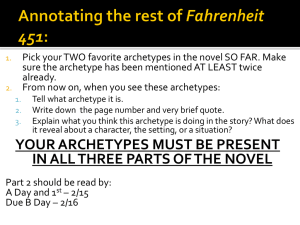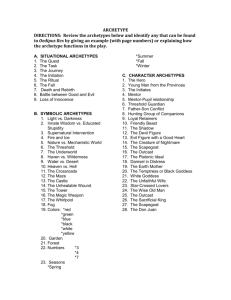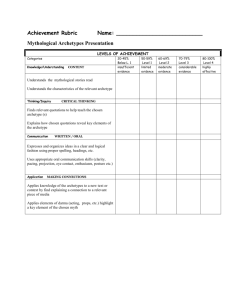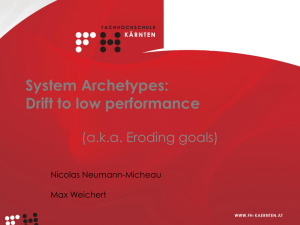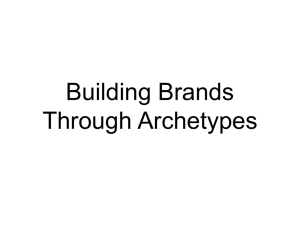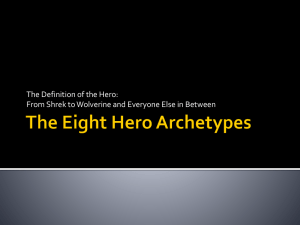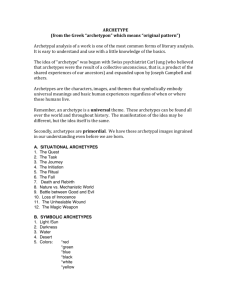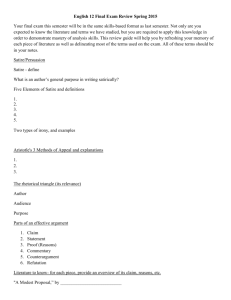SemanticMining Semantic Interoperability and Data Mining in Biomedicine Deliverable 26.2
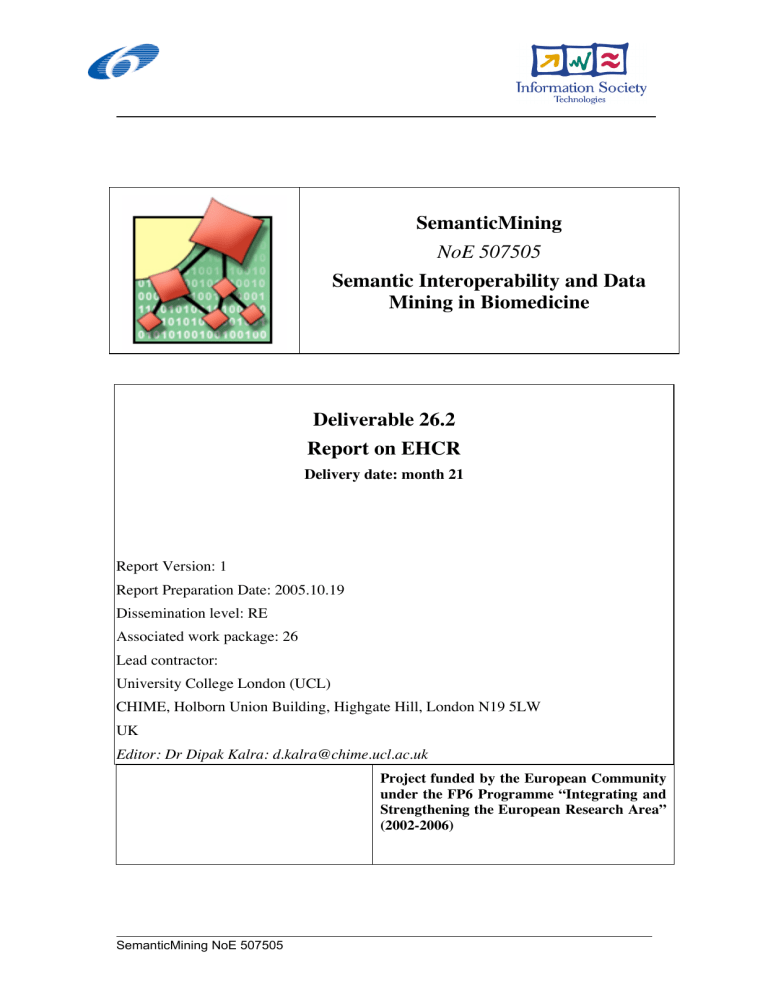
SemanticMining
NoE 507505
Semantic Interoperability and Data
Mining in Biomedicine
Deliverable 26.2
Report on EHCR
Delivery date: month 21
Report Version: 1
Report Preparation Date: 2005.10.19
Dissemination level: RE
Associated work package: 26
Lead contractor:
University College London (UCL)
CHIME, Holborn Union Building, Highgate Hill, London N19 5LW
UK
Editor: Dr Dipak Kalra: d.kalra@chime.ucl.ac.uk
Project funded by the European Community under the FP6 Programme “Integrating and
Strengthening the European Research Area”
(2002-2006)
SemanticMining NoE 507505
Table of Content
TABLE OF CONTENT
ADMINISTRATIVE INFORMATION
SUMMARY
1 OVERVIEW
1.1 Objectives
1.2 Milestones
1.3 Project meetings
1.4 Deviations from Plan
2 MAIN RESULTS
Introduction
The role of Archetypes
Binding Record Structures and Terminology
Negation
Linking questionnaires in use with archetypes based on a generic model such as CEN EHRCOM or HL7 RIM 14
Applying ontologies to support interoperability between guideline management systems and electronic health records 19
9
11
Conclusion 20
6
6
7
4
4
4
4
5
2
3
3
SemanticMining NoE 507505
Administrative information
Lead contractor/partner for WP/Deliverable
University College London
Assisting partners for WP/Deliverable
University of Manchester
INSERM
CNR-ISTC
Linkoping University
Contributors list
UCL:
UoM:
INSERM:
CNR-ISTC:
Li:
Dipak Kalra
David Lloyd
Thomas Beale
Nathan Lea
Alan Rector
Jeremy Rogers
Rahil Qamar
Christel le Bozec
Bruno Frandji
Marie-Christine Jaulent
Patrice Degoulet
Julie Niès
David Ouagne
Thierry Delbecque
Domenico Pisanelli
Hans Ahlfeldt
Erik Sundvall
Summary
This deliverable is the second for Workpackage 26. The first, submitted after
Month 12, summarised the areas of research that the partners had identified as being relevant to the semantic indexing of the EHR. This second one reports progress on the key threads of work identified by the partners during the project to contribute towards semantically interoperable and processable EHRs.
This report provides a set of short summaries on key topics that have emerged as important, and to which the partners are able to make strong contributions. Some of these are also being extended via two new EU Framework 6 proposals that include
WP26 partners: this is also a measure of the success of this Network of Excellence.
SemanticMining NoE 507505 3 Deliverable 26.2
1 Overview
1.1 Objectives
Objectives
To define an interoperable means of specifying classes of data within the EHR with sufficient granularity and precision that clinical applications, decision support systems and other tools can create or retrieve data values or sets of patients that precisely match any given clinical criteria.
To support the future seamless and standards-based interaction of knowledge, record and inference services.
Progress towards achieving objectives
Each of the partners is continuing research and development activities in line with those summarised in Deliverable 26.1 last year.
Not surprisingly, some collaborative themes have emerged, and joint activities are now beginning within WP26. Many of the work threads also feed into wider international collaborations and to international (CEN,
ISO, HL7) standardisation.
1.2 Milestones
Milestone
Exploration of the way in which archetypes can be linked to terminology and ontology resources
Exploration of terminology and record structure binding issues: proposals for in depth investigation
Further exploration of binding of
SNOMED-CT to archetypes
Review of OWL representation of archetypes
Planned date
May 2005
May 2005
November
2005
December
2005
Actual date
May 2005
May 2005
Comments
1.3 Project meetings
Milestone
2 day WP26 workshop for WP26 partners: review of research threads and agreement of new activities
Planned date Actual date
N/a 27 & 28
May 2005
Comments
A very successful meeting, with both days focussing on the actual work and semantic challenges relevant to WP26
SemanticMining NoE 507505 4 Deliverable 26.2
1.4 Deviations from Plan
Causes and Description
Nothing to report
Corrective actions
SemanticMining NoE 507505 5 Deliverable 26.2
2 Main Results
Introduction
Workpackage 26 of the Semantic Mining NoE defines and manages a thread of research activity on semantic aspects of the electronic health record. The core challenge being addressed is to enable EHR data to be semantically “indexed” so that retrieval, decision support and population analyses can be performed on EHr data even if those data have been accumulated from diverse and dispersed clinical applications, and even if different terminology systems have been used. This is a complex challenge, topically considered to be subsumed by the phrase “semantic interoperability”. However, semantic interoperability is still a rather imprecise vision, whist the challenges being addressed by WP26 permit a more focussed set of workplan threads to be pursued.
In the first WP26 deliverable (Del 26.1, submitted at the end of Year 1), this general area of challenge was described, and the expertise of each partner summarised. Work had really only just begun on understanding these challenges, and the deliverable outlined a set of intended research journeys to be pursued during year 2.
This deliverable is able to report on the progress that has been made in understanding the sub-components that contribute towards semantic indexing of the EHR (and therefore contribute towards semantic interoperability). The specific areas of work into which semantic indexing have been divided are listed below.
1. The potential role of Archetypes to support consistent recording and safe analysis; the requirements for safe/valid data mining; archetype representation and archetype policies.
2. Record structures and terminology binding. What are the difficulties, why are they a problem, and what work is emerging to help towards semantic interoperability. A specific example topic of current importance is the handling of negation, which is discussed in more detail in this report.
3. Representing patient questionnaire data within a generic EHR model (such as
CEN/ISO 13606-1); enabling the analysis of these data in conjunction with clinicianauthored record entries.
4. Applying ontologies to support interoperability between guideline management systems and electronic health records.
Progress on each of these topics is given below. Each topic summary provides an outline of the problem being addressed, a paragraph about what the problem is; the progress being made towards tackling the problem, including the contribution made by through Semantic Mining; a resume of the current approach being taken and what future work and contribution is intended by the Partners during 2005-6.
SemanticMining NoE 507505 6 Deliverable 26.2
The role of Archetypes
An introduction to the archetype concept was given in Deliverable 26.1. The problem that archetypes seek to address is to provide a systematic and potentially standardisable framework for defining and sharing the data structures within an EHR that are needed to represent each distinct clinical information entity, at an appropriate level of granularity. Archetypes are an evolution of results from previous EU-funded projects (in particular, Synapses) and other international (notably Australian) work.
The specification is held and maintained by the open EHR Foundation, an international not-for-profit company of which one of the Semantic Mining partners
(UCL) is a founding shareholder. The archetype approach is now also in the process of being standardised at a European level by CEN TC/251.
Unlike fixed-content healthcare messages that have hitherto been defined to support patient registration, claims, episode and HRG returns, population screening and disease registers, the support of clinical shared care and longitudinal care require the communication of fine grained and diverse clinical data structures within a coherent and harmonised framework. The first step in EHR interoperability is to define a generic framework, often called an EHR Reference Model. Considerable experience now exists of the ideal characteristics and requirements for such a model, and forthcoming standards from CEN and ISO (EHRcom: CEN/ISO13606) will enable
EHR data to be communicated internationally in ways that preserve their internal structure and medico-legal provenance properties. However, by being generic such models are deliberately devoid of clinical domain (clinical semantic) concepts. Whist permitting flexible and faithful representation of the underlying clinical data, this approach also risks heterogeneous approaches to how particular clinical data structures are represented. An EHR Reference Model therefore enables faithful EHR communication but only plays a limited role in supporting semantic interoperability.
It is widely accepted that archetypes, when used to constrain a generic EHR
Reference Model such as the open EHR RM or that defined by prEN13606, provide a first layer of semantic coherence and thereby offer a basic foundation on which fine grained semantic interoperability can be built. A major activity undertaken in the past year has therefore been to refine the archetype approach, both within open EHR and within CEN TC/251, led by UCL. The work undertaken includes the drafting of archetype requirements, a complete and machine process-able UML logical representation for archetypes, refinements to an Archetype Definition Language, and the creation/refinement of archetype authoring tools, validation tools and a first version of an archetype repository (UCL in partnership with Ocean Informatics in
Australia). Much of this work is now incorporated into a CEN Enquiry draft of prEN13606-2: Archetype Interchange Specification, and will be taken forward in an accepted New Work Item Proposal: Archetype Knowledge Framework. Much of this work has been shared with HL7 (via the Templates Special Interest Group) and this group is presently reviewing the archetype specifications (starting with requirements) with a view to potential adoption or adaptation for use within HL7 version 3.
SemanticMining NoE 507505 7 Deliverable 26.2
Other Semantic Mining work that is at an earlier stage of research includes investigations of optimal ways to bind archetypes to terminology systems, the crossrepresentation of parts of an archetype in OWL to support reasoning queries, the mapping of archetypes to patient questionnaires and the representation of knowledge constructs within guidelines (via ontologies). These work items have required crosspartner collaboration within WP26.
The next phases of work to be undertaken within WP26 on archetypes are: to explore further the mapping of archetype semantics within OWL and establish clearly the value of achieving this; mapping archetypes within a repository to an ontology (using
Protégé) to permit indexing and selection of relevant archetypes; mapping archetype concepts to key terms that can in turn be linked to educational resources so as to permit patients to understand more about their own health through the EHR. A recent archetype-based query component has been implemented as part of a UCL EHR server, and will be extended over the coming year to support quite complex research
(data mining) queries.
A key consideration that will determine the value of archetypes in promoting coherence of EHR organisation is the quality and consistency of the archetypes themselves. This requires formal policies and quality criteria, and a governance authority, to ensure that archetype definitions are rigorous, meet appropriate clinical evidence, avoid unnecessary duplication or overlap, and are managed in a regulated way. The set of governance policies and a governance body is being established through the open EHR Foundation, and a new EU Framework 6 project (Q-REC) will be developing quality criteria and exploring accreditation mechanisms for archetypes.
Semantic Mining WP26 partners are involved in both activities.
SemanticMining NoE 507505 8 Deliverable 26.2
Binding Record Structures and Terminology
The Problem
Medical information systems differ from most other information systems in that the terminology model and information or messaging model are developed separately, e.g. HL7 develops messaging models to be used with terminology models developed by LOINC, SNOMED, ICD9-CM, etc. Similarly, the same set of Archetypes in an open EHR/CEN 13606 EHR model might be used with any of the above or various national variants or other terminologies.
This poses three problems:
Joint meaning: The meaning of any statement in a message or EHR can only be understood by combining the meanings of the information/message model and the terminology model. This means that for any given Message/EHR model-
Terminology pair, there needs to be a transformation of combined statements to a single joint canonical form for querying.
Partitioning and mutual constraints: The scope of the information/message model and the terminology model overlap, so that there are things that might be said in either or both. For example, there is a family history marker in most EHR/Information models and there are also terms for “Family history of…” in most terminologies.
(SNOMED has an entire section on ‘context’ to deal with such issues.). This means that there must be a principled partitioning of information between any given terminology system and any given EHR/Record model, represented by mutual constraints.
Negation and Null values: A particular problem of context is negation. Negation has a different logical status from context markers such as “Family history of” because it has a well defined logical semantics that must be respected. Negative findings such as “Absent pedal pulses” or “Loss of consciousness” present special problems.
This problem is becoming more acute with the use of more expressive terminologies such as SNOMED-CT. It is made still more acute by the decision of the UK national
Health Service, now the largest user of the combined HL7 version 3 and SNOMED-
CT systems that all clinical information should be represented in SNOMED.
Many of these issues focus on the relationship between the SNOMED-CT ‘Context model’ – that portion of the terminology that determines ‘Family history of…’, ‘Past history of…’ , ‘Risk of…’ etc and related attributes in the HL7 RIM and EN13606 data model.
In addition to the above three issues of principle, there are many more specific issues relating to each information/messaging model – terminology pair, e.g.
SemanticMining NoE 507505 9 Deliverable 26.2
The exact meaning of the HL7 ‘Code’ and “Value’ attributes, and whether a finding – e.g. Diabetes – should appear in one, the other, or both, possibly with different wrappings.
Matching and equivalences of complex post-coordinated SNOMED terms and similar information expressed in either EN13606 or SNOMED by relations between multiple statements.
Current Developments and Activities
Currently four are at least three active streams of work internationally on the problem of binding terminology and EHR/Message structures:
The HL7 Terminfo working group, which is explicitly concerned with the use of
SNOMED-CT within HL7-V3 messages
The work on Archetypes within the OpenEHR/CEN EN/13606 (Electronic Healthcare
Record Architecture) development stream
PhD research by Rahil Qamar sponsored by the Semantic Mining project developing mechanisms for Archetype authors to bind their work to specific terminologies and produce accompanying conformance testing.
Contract work with the NHS National Program for IT on a common representation for
SNOMED and HL7 v3 in OWL to support a common reference resource and conformance testing.
All three groups involve many of the same individuals. Key documents are available from SNOMED under their Concept Modelling Working Group. The group is semiopen, but the documents are normally considered proprietary and not circulated.
These include detailed textual rules for constraints.
State of the Art
For both CEN EN13606/ open EHR and HL7-v3, the issue of a computable, machine readable binding for terminology and message/EHR models remains an open question. Progress is being made in setting the requirements for such expressions in text form.
The feasibility study of a joint representation in OWL, partly based on work within
Semantic Mining, has been very well received in both the NHS and HL7 and larger scale development is under active consideration.
SemanticMining NoE 507505 10 Deliverable 26.2
Negation
The problem
The meaning of negation in clinical records is often ambiguous. In addition, mechanisms for negation exist both in most message/EHR models and in most terminologies. To make matters more difficult still, many terminologies do not indicate negation consistently, so that a single code may indicate “No intracranial bleeding” or “Not pregnant”.
There is no clear stated policy in most systems about the difference between failure to mention a finding and the patient definitely not having the finding. For example, is it safe to assume because there is no mention of diabetes in a patient’s record that they do not have diabetes? When retrieving all patients with kidney disease but without diabetes from a database should patients only patients for which it is explicitly with kidney disease for whom it is explicitly stated that they do not have diabetes be included, or should all patients for whom there is no entry for diabetes be included?
Secondly, whereas most findings are abnormal when present and normal when absent, some such as ‘pedal pulses’ are normally present and abnormal if absent. Such negative findings add particular confusion.
Furthermore, the scope of negation is often ambiguous in the formal representation.
Although the natural language is normally clear, the formal representation often makes it difficult whether a given combination of attributes means “No family history of diabetes”, “Family history of non-Diabetes” or “Diabetes but not a family history of diabetes”.
Thirdly, many classification terms, particularly in ICD related systems are of the form
“Head injury without intracranial bleed” or “Peptic ulcer with haemorrhage but without perforation”.
Finally, to confuse matters further, until recently, the computationally tractable formalisms used for complex terminologies such as SNOMED or GALEN did not support negation properly. Newer representations such as OWL can support negation properly but are not yet in widespread use.
There are therefore two issues:
Clarity on the intended meaning and scope of negation in any given
1. The distinction between explicit negation and non-mention
2. Simple findings
3. Compound findings using ‘with’/’without’ or similar constructs
4. ‘Negative findings’ such as ‘pedal pulses’
5. Negation involving context
A formal representation which provides a faithful model of the intended meanings and distinctions.
SemanticMining NoE 507505 11 Deliverable 26.2
Intended meaning
Of the above five issues concerning the intended meaning
1. The distinction between explicit negation and non-mention: It is generally agreed that this distinction must be maintained in such a way that query mechanisms can query for either depending on the circumstances.
2. Simple findings – Present few problems in themselves as to meaning, but see formal representation below
3. Compound findings using ‘with’/’without’ or similar constructs – again provide little argument about meaning but much about representation
4. ‘Negative findings’ such as ‘pedal pulses’ – There is a growing consensus in both
HL7 and CEN, that terminology for negative items needs to be divided into two cases: a) Those in which the negation genuinely means the absence of some condition: e.g.
‘no endocrine disease’, and b) those in which the negation is best regarded as a linguistic artefact best treated as an ‘observable’ (analogous to a laboratory test’ with value of ‘absent’ or ‘zero’. These two cases can be distinguished by two criteria: i)
Whether the best interpretation is a) “The patient does not have any X” or b) “The patient does not have some X’. ii) Whether the only possible values are present/absent or whether there might be a scale, e.g. absent, reduced, normal, augmented. In each case, the finding should be treated as a ‘simple’ finding if the first criterion applies; as an observable with a possible value of ‘absent’ or ‘zero’ in the second.
Formal representation
The issue of formal representation is discussed in a draft paper being prepared for preparation. The issues can be focused on the following.
It is never the finding itself that is being negated: i.e. . the meaning is not Patient has
‘non-diabetes’
To achieve a uniform representation, it is more effective to ‘wrap’ all findings and observables as aspects of a ‘Clinical Situation’. One can then represent negation easily:
Clinical situation that includes head injury and does not include intracranial bleed.
It should be noted that none of the existing coding systems conform to these criteria, and that the SNOMED-CT context model poses particular problems, since it includes a ‘qualifier’ for negation and then elaborate rules for treating it differently from other
‘qualifiers’. The fact that in SNOMED the ‘context’ is parallel to rather than wrapped around the finding, also means that, even were the negation treated properly in a stronger representation, the result of negating, for example, ‘family history of diabetes’ would be ambiguous and not give the intended results using conventional
SemanticMining NoE 507505 12 Deliverable 26.2
semantics. There are straightforward transformations that overcome these problems, but they have not yet been accepted nor implemented.
SemanticMining NoE 507505 13 Deliverable 26.2
Linking questionnaires in use with archetypes based on a generic model such as CEN EHRCOM or HL7 RIM
For hospitals having already implemented the EHR, where hundreds of models of questionnaires have been designed and are used in daily practice, the issue is to propose methods and/or tools for:
designing new questionnaires making use of shared validated professional/business objects models i.e archetypes (as they are or after specialization or customization) based on generic EHR models such as open EHR, CEN EHRcom or the HL7 RIM.
contributing to archetype authoring (proposing existing questionnaires and/or parts of questionnaires to be candidate to become archetypes)
The collection of questionnaires used at large scale represents an interesting basis for the design of archetypes that could be consensual at least within a domain of application such as hospitals, hospital groups, healthcare regional networks.
sharing documents and/or questionnaires with others hospitals relying on archetypes linked with reference terminology/ontologies maintained into a repository
developing and sharing Decision Support modules relying on questionnaires and concepts
In order to address these issues there is a need to link the professional/business objects models currently based on proprietary data models from Electronic Healthcare Record
Systems in use and the available generic EHR models.
Current developments and activities
HEGP
The component-based information system of HEGP (Georges Pompidou University
Hospital, “Assistance Publique - Hôpitaux de Paris” (AP-HP) includes computerized orders, results and notes. A decision support system for computerized ordering of medications is under development.
A hospital policy was voted in May 2004: to enter computerized notes in the EHR as structured questionnaires for most encounters. For hospitalisations, reports built from computerized notes will be sent to the referring physician before at least 8 days after outcome. The migration of pre existing specialized records into the structured questionnaires of the medical record component is on the way.
SemanticMining NoE 507505 14 Deliverable 26.2
This experience has already given evidence or problems to be solved like the distinction between question concepts and response concepts, how to infer response concept from binary (yes/no), numerical or free text values and how to link both sets to terminologies.
The current issue is the progressive sharing of documents with affiliated institutions, practitioners and patients.
UCL
UCL is a joined founder of the open EHR foundation and works closely with its cofounding partners Ocean Informatics. In particular, The Ocean Archetype Editor is a tool that supports the authoring of archetypes as part of the open EHR initiative and the CEN EHR standardisations. UCL has done a lot of work on the development of archetypes. It brings significant experience on the design and use of archetypes in live clinical EHR settings. A recent project incorporates placeholders on the integration of medical knowledge (in the ontology domain) and protocol services.
CEN TC251
As part of WG1 activities, after the previous releases of Pre- European Normative
Vouchure (1995) and European Normative Vouchure (1999) a European Normative document is under development to deal with Electronic Healthcare Record
Communications (EHRcom).
This document includes a generic model of Electronic Healthcare Records supporting
European requirements for EHR management and communication. It also defines precisely the archetype paradigms and provides the means to design and use archetypes within EHR systems. Some archetypes are also to be referenced within the document together with how to address the underlying security/confidentiality issues that inevitably emerge when trying to address the issue of EHR interoperability.
HL7
HL7 provides many threads of activities in this field, based on the RIM generic model whose scope is broader that EHRs and on the CDA Clinical Document Architecture.
Numbers of RIM and CDA based professional/business objects are being designed.
HL7-France
Within a HL7-France specific working group, templates of RIM-based CDA are designed in two areas : general medical observation and pathology reports in oncology. They are professional/business objects models including other reusable professional/business objects like “allergies”, “antecedents”, etc.
These models of CDA are to be used for cross-healthcare enterprise sharing in two frameworks : the French personal medical EHR (DMP project from the ministry of health) and the Communicating EHR in Oncology (promoted by the Cancer Institute).
ARTEMIS
SemanticMining NoE 507505 15 Deliverable 26.2
Within the Artemis project, ebXML Registry semantic constructs were used for annotating, storing, discovering and retrieving archetypes.
To realize archetype based interoperability, the healthcare systems need to identify the accurate existing archetypes based on their semantics; In order to achieve this, archetypes are annotated using ontologies and this annotation is used for archetype retrieval; The authors also described how archetype data can be retrieved from clinical information systems by using ebXML Web services.
Since healthcare systems exploit different ontologies based on the domain knowledge through different standard bodies like HL7, CEN TC/251, ISO TC/215, interoperability is not easily achieved. Within the Artemis project a Web Service architecture, adapted from the Semantic Web solutions has been developed. This architecture does not propose globally agreed domain models (HL7 RIM, CEN models…) but a mediator component enabling healthcare institutes to reconcile their semantic differences. The mediator component uses ontologies based on prominent healthcare standards (HL7, CEN) as references to facilitate semantic mediation among involved institutes.
MEDIQ
MEDIQ (Danish consultancy company) is involved in projects developing clinical guidelines, care management plans and medical decision support systems based on reusable semantic building blocks. As part of their work professional/business EHR objects are being designed.
State of the art
For healthcare systems to exchange information in an interoperable manner, they need to discover the professional/business objects (archetypes and templates (CMET, etc)) communicated and their associated semantics.
ebXML Registry, through its semantic constructs, provides an efficient medium to annotate, store, discover and reuse of archetypes. More over, using Web services to support interoperability of hospital systems relying on different standard domain models (HL7, CEN) and different domain ontologies has being reported in the literature.
Currently, describing the semantics of Web services is a very active research area.
OWL-based Web service ontology is a comprehensive effort designing an upper ontology for Web services. The use of artificial intelligence techniques for discovering services through OWL-based languages is also addressed in the literature.
More over, the emerging P2P paradigms could be an opportunity to improve semantic interoperability, providing a solution to achieve semantic agreements. It is argued that establishing local agreements is a less challenging task than establishing global agreements by means of globally agreed schemas or shared ontologies. Once such
SemanticMining NoE 507505 16 Deliverable 26.2
local agreements exist, through the “semantic gossiping” process proposed, global agreements can be achieved in a P2P manner.
SemanticWeb EnabledWeb Services (SWWS) architecture is a basis to develop solutions to provide semantic web services for archetypes sharing. It is largely stated in literature how ebXML registries can be enriched with Web service semantic.
S upporting interoperability between hospital systems relying on different standard domain models (HL7, CEN) and different domain ontologies require the use of ontology mapping components.
As regards the interoperability of points of view, many works propose knowledge integration solutions based on ontologies.
According to Wache, three approaches for the integration of various knowledge are generally distinguished :
- The single ontology approach uses a global ontology providing a shared vocabulary for the specification of the different sources.
- In the multiple ontologies approach, each source is described by its own ontology and an additional representation formalism defining the intermapping ontology is provided.
- Finally the hybrid approach combines the two previous ones. Each source is described by its own ontology built upon one global shared vocabulary. The main point is how the terms of the source ontologies are described by the primitives of the shared vocabulary.
The technical solutions developed to allow managing multiple ontologies can be classified according to the operations they can handle (difference, mapping, transformation, versioning management, etc.) or according to the local ontologies one has to deal with. One of the difficulties of multiple ontologies approach and the
"hybrid" one is the definition of the mapping. There are several environments making operations of mappings (like the PROMPT suite, Open Source software). The environment to be used must be chosen according to the task envisaged and to the local ontologies which one has to deal with.
Intended contribution by the group
•
Collect questionnaires in the following medical areas : Generic Medical
Observation ,Oncology, Cardio Vascular Radiology, AVK, etc
•
Author archetypes from the collected questionnaires using Protégé and OWL in collaboration with the other semantic mining teams
SemanticMining NoE 507505 17 Deliverable 26.2
• Define the features that would enable a satisfactory management of the distinction between question concepts and response concepts, how to infer response concept from binary (yes/no), numerical or free text values and how to link both sets to terminologies.
•
Design scenarios describing the interactions between a clinical decision support system (CDSS) and the HEGP EHR system. Establish a list of concepts which could be present and accessible to allow the CDSS to make use of the patient medical information stored within its EHR
• Evaluate the needs for archetypes repositories and organisation and describe the services they should offer within various domains of applications
SemanticMining NoE 507505 18 Deliverable 26.2
Applying ontologies to support interoperability between guideline management systems and electronic health records
The problem and general approach
Nowadays health-care provision is more and more characterised by the enactment of clinical guidelines, also in the daily practice. Fundamental is their role – for instance – in the prevention of medical mistakes, acting basically as a reminder for things to be done, questions to pose, data to be taken and so on.
Although representing the kind of knowledge needed to enact clinical guidelines may seem the only issue, it is not neglectable to solve the crucial problem of interfacing in real-time the guideline management system and the electronic health record. Both systems have to speak the same language, and they usually don't. Ontologies are the
"glue" needed to bridge the two worlds.
Present work in the field
Apart from its definition in the philosophical context - where it refers to the subject of existence - ontology in the medical context is "a partial specification of a conceptualization". There are ontologies in many specifical domains of medicine
(some of them are reported in www.openclinical.org ). On the other hand, many efforts have been devoted on the design of so-called "top-level" ontologies, i.e.
domain independent ontologies, like the DOLCE foundational ontology . What still lacks is a useful "reference ontology" in the field of medicine, i.e. a domain ontology with general medical concepts.
Future direction
The Laboratory of Applied Ontologies of CNR in Rome has been designing a clinical medicine reference ontology whose aim is to act as an "ontology mediator" in order to ensure semantic consistency among heterogeneous health-care information systems, including the EHR and the guideline management system. This reference ontology currently consists of 121 concepts linked by 17 different relationships. It has been implemented by means of the RACER description-logic and can be browsed by the Protégé tool.
SemanticMining NoE 507505 19 Deliverable 26.2
Conclusion
Many of the issues being tackled in WP26 are complex conceptual problems, requiring deep understanding of the semantic challenges involved in systematically representing diverse and evolving clinical concepts and data structures. The partners and their research teams have progressed considerably in both individual site activities and inter-site collaborations. It is difficult to capture in the form of a report the growing richness of this mutual understanding, or to project clearly how these innovative threads of work will contribute to next-generation solutions to the semantic indexing of EHRs. It is clear, however, that the work being done by the WP26 partners is being recognised internationally as a set of strong contributions. From the starting point of a loosely coupled set of university sites, the WP26 team is gaining momentum as an affiliated set of experts conducting world-leading research. New EU and other funded projects are starting to enable specific aspects of this challenge to be addressed to a greater depth.
SemanticMining NoE 507505 20 Deliverable 26.2
